Decorating a Craftsman Home With Vintage Furnishings
Craftsman homes, also known as “bungalow homes,” are popular in California, the American west, and in other locations around the world. Typically, a craftsman home is one and a half stories high, featuring an open floor plan that includes a fireplace and a central living space. You’ll sometimes find hallways in a craftsman style home, but it’s also typical for rooms to be connected without any hallways.
Many craftsman homes, particularly older homes, are well-suited for decorating with vintage furniture, linens, art pottery and other accents. If you think you’d like to try this style of decorating, read on for pictures, ideas and suggestions.
Craftsman Living Room Furniture
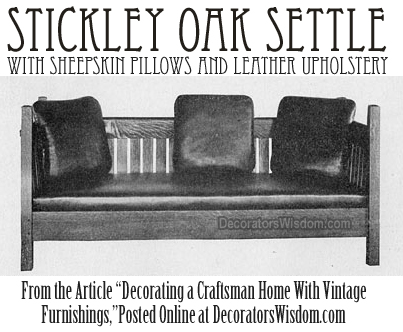
Craftsman living room furniture was typically made of white oak wood. If there was any upholstery, it was usually leather. In an early 1900s Craftsman home, you wouldn’t likely have found pieces like sofas, love seats and recliners like the ones that are so popular these days. Instead, you would have been likely to encounter furniture such as settles with cushions, Mission style wooden rockers, or wooden lounging chairs.
Built-In Furniture

Sometimes, you’ll find that both furniture and light fixtures are built right into the structure of a craftsman home. For example, seating might be built into the walls of the living space, or a cupboard might be built into the wall in the dining room or kitchen.
The Craftsman Dining Room
Craftsman Style Dining Room Furniture: Historically, Craftsman furniture was made of white oak, and accented with leather. It was typical to include a patterned area rug in the William Morris style. Perhaps a Tiffany stained glass lamp would hang over the dining room table. This aesthetic is easy for today’s homeowner to mimic, as an abundance of both original and reproduction furniture are available.

Table Linens: Typically, one or more plain linen table runners, or perhaps runners with appliques or simple embroidery, would adorn the dining room table in a Craftsman home. If embroidered, the embroidery threads could be of linen or silk, and they were often colorful. The couching style of embroidery was popular, and embroidered designs were often simple and linear, featuring geometric, floral or native American inspired patterns.

Lighting and Accessories
Craftsman houses incorporated a variety of different lamps and lighting elements, including pendant lamps, floor lamps and table lamps.

Louis Comfort Tiffany’s name was frequently mentioned in The Craftsman magazine, and his work is popular with collectors of Craftsman furniture. Tiffany produced a number of different lighting designs that coordinated well with the mission furniture style, including pendant lamps, table lamps and floor lamps.
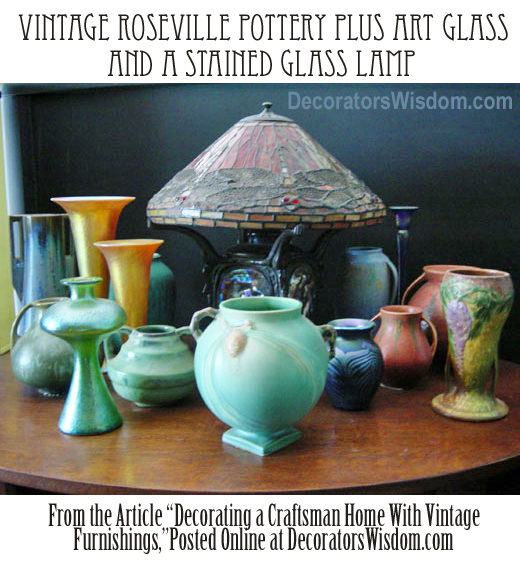
Vintage Pottery and Art Glass
There were many active potteries at the same time Gustav Stickley was producing furniture. Roseville was one of the most popular. Others included Van Briggle, Rookwood, Grueby, Teco, and Fulper.

Roseville was actively producing pottery long after Gustav Stickley stopped publishing The Craftsman in 1916. Stickley’s earliest furnishings tend to be most prized by collectors, and some purists would insist on only decorating with the pottery from the same time period (around 1901 – 1904.) However, some of Roseville’s most popular designs weren’t released until the 1930s. For example, the Roseville Pinecone pattern was a 1930s design, and it was extremely popular with collectors.
My opinion: Roseville Pinecone bowls and vases complement the Craftsman style beautifully. Also, most of the vintage art pottery by Roseville or any other of the above-mentioned makers is suitable for decorating a craftsman home.
Some decorators would advise you to choose pieces made in the same time period as your furniture. My own advice would be to choose pieces that your heart responds to — pieces that fill you with joy when you look at them.
Art glass also makes a lovely addition to a Craftsman home. Look for pieces by makers such as Louis Comfort Tiffanny, Steuben and Loetz.

Craftsman Kitchens and Kitchen Decor
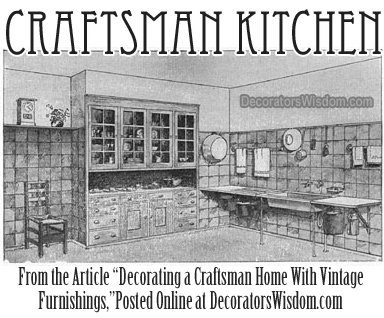
Looking through past issues of The Craftsman and Gustav Stickley’s other publications, it occurs to me that we don’t have all that many authentic historical examples of what a Craftsman kitchen should look like. We do, however, have an in-depth two-page essay featured in the Craftsman Homes book from 1909, titled A Convenient and Well-Equipped Kitchen That Simplifies the Housework. From this text, we learn that, ideally, Craftsman kitchens should be comfortable, unpretentious and functional. The example pictured here originally accompanied that article. The illustrated kitchen features tile walls plus built-in furniture and a sink, with dish towels and linens hung conveniently close at hand.
See Also: All About Kitchens
Decorating a Craftsman Style Bedroom
In the October 1904 issue of The Craftsman, author Mary Augusta Mullikin wrote the following caption for the picture below:
“Scheme for a bedroom in which the lines of the furniture are made to repeat or echo those of the architecture.”
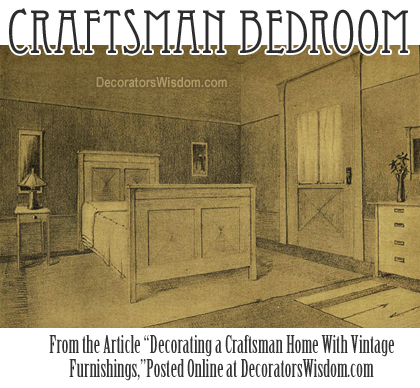
From this illustration, we can deduce a couple of things: that coordinating headboards and footboards were of interest to the Craftsman tribe, and that the characteristic Craftsman lines and simplicity carried through to the bedroom.
There was a distinct difference in the look and feel of the bedroom furnishings featured in the earlier years of The Craftsman vs the later years.

As Mission furniture declined in popularity, Gustav Stickley released the Chromewald collection, a furniture collection which evolved away from the clean lines of the mission style. The Chromewald pieces included decorative elements, such as stands that featured twisted legs and beds with curving, knobby posts.
1916 was a tough time for Gustav Stickley. His Chromewald collection never really caught on with the buying public. His furniture declined in popularity to the point that he stopped publishing The Craftsman, and even ceased producing furniture.
Pictured here is a bed from the Chromewald collection, which was published in the November 1916 issue of The Craftsman, the month before the publication shut down. The bed in the photo is covered with a simple Craftsman-style linen cover. If you could find such a bedspread today, it would make a remarkable addition to a Craftsman-style bedroom.
Having said that, the bed itself isn’t such a hot example of what collectors think of as “Craftsman style.” Although it bore the Stickley name and label, Stickley’s earlier furnishings have been much more collectible than this example.
What to Do When You Can’t Find Suitable Craftsman-Style Table and Bed Linens for Your Home
It’s reasonably easy to find vintage Craftsman and Mission style furniture in livable condition — but it’s rarer to find antique table linens and bed linens that have survived without accumulating serious flaws. Most of the linens I’ve come across from the Craftsman era have broken threads, frayed areas, holes, brown spots, stains and missing chunks of fringe. Those that have survived in usable condition are priced accordingly high — if you can find them to start with..
If you’re interested in owning and actually using linens from this era, making your own can be a viable alternative to buying originals. I suggest buying original pattern books from that time period, which are available much more affordably than the actual linens are. Here are some suggestions for publications that include appropriate patterns:
- Many of the issues of Home Needlework Magazine from 1901-1915 have appropriate patterns and design inspiration you could use. This publication often featured color illustrations for embroidered designs in the Art Nouveau and Mission styles.
- The Library of Work and Play from 1911 includes a rich variety of information you could use for crafting era-appropriate linens.
Newer Linen Designs That Are Compatible With the Craftsman Style Aesthetic:
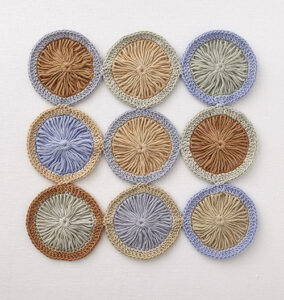
Crochet Loom Blooms is a brand new book by Haafner Linssen, published by Interweave / The Quarto Publishing Group. This book includes multiple patterns for handmade textiles that would work well in contemporary Craftsman style homes. These patterns feature hand-loomed flower motifs, some of which are combined with crochet work and others which aren’t. You can use groupings of these motifs as insertions to create visual interest in your table linens, or you could create linens and bedspreads entirely using these motifs.
“Formal Flower Bed” and “Regent’s Park” are two of the most appropriate designs to consider using from this book; these would work well for making table runners, dresser scarves, coverlets or a broad variety of other table and bed linens. “Flower Fair”, “Happy Harvest”, “Stockholm Gardens” and “Doting on Dots” are other patterns from the book that you could consider incorporating into a Craftsman-style home (any of these could easily be recolored to match your own furnishings — which is important, because some of the original colorways pictured in the book are trendy now but not necessarily examples of period-appropriate color combinations.)
- Click here to find more information about Crochet Loom Blooms in a detailed book review.
- Click here to shop for Crochet Loom Blooms or see a book preview at Amazon. They have the “look inside” feature enabled, so you’ll be able to see some of the images and content from the book.
Materials for Making Your Own Reproductions of Craftsman-Era Bed Linens and Table Linens:
When making your own Craftsman-inspired linens, the most appropriate materials to use are linen or linen-cotton blend fabric with silk embroidery floss. Cotton embroidery floss and cotton fabric can also be suitable. For crochet work, use mercerized cotton yarn, linen yarn or cotton crochet thread. You can usually find vintage fabric, embroidery floss and crochet thread for sale on the secondary market in better condition and less expensively than finished linens are. Avoid using synthetic materials. If you can’t find suitable vintage materials and want to use newly-produced materials, certified organic fabric, yarn and embroidery floss are the next best thing to vintage.
We hope this information is helpful to you if you’re interested in decorating a Craftstman-style home with vintage furnishings. We wish you all the best with finding or crafting suitable decorative items for creating a pleasing and comfortable environment.
References
- Craftsman Homes, 1909, by Gustav Stickley. Articles: An Outline of Furniture-Making in This Country: Showing the Place of Craftsman Furniture in the Evolution of an American Style, pp. 151-159; “A Convenient and Well-Equipped Kitchen That Simplifies the Housework,” pp. 142-143; The Dining Room as a Center of Hospitality and Good Cheer, pp. [unnumbered]-141.
- The Craftsman, February 1904 issue. Article: Recent English interior treatments, pp. 508-512
- The Craftsman, October 1904 issue. Article: Precious Things, pp. 67-68 by Mary Augusta Mullikin.
- The Craftsman, November 1916 issue, Chromewald furniture advertisement.
Posted By: Amy Solovay
This page was last updated on 8/31/2023.
Decorating a Craftsman Home With Vintage Furnishings
See pictures and ideas for decorating a craftsman home or bungalow with vintage furniture, art pottery, and antiques – Gustav Stickley furniture and more.
decorating a craftsman home with vintage furnishings, built-in furniture, Tiffany stained glass lamps, Roseville pottery, art glass, Gustav Stickley, settle, leather, white oak wood, craftsman dining room, craftsman kitchen, craftsman bedroom, craftsman living room, craftsman interiors, craftsman interior design, craftsman antiques, craftsman pottery, arts and crafts pottery, arts and crafts style, mission style